Rat-baiting
Rat-baiting is a blood sport involving the baiting of rats in a pit. It was a popular sport until the beginning of the 20th century. Rat-baiting involved filling a pit with rats and then placing bets on how long it would take for a terrier to kill them all.
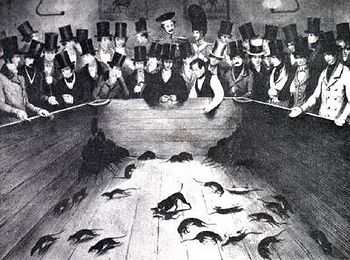
History
In 1835, the Parliament of the United Kingdom implemented an Act called the Cruelty to Animals Act 1835, which prohibited the baiting of some animals such as the bull, bear and other large animals. However, rat baiting was not enforced and ratting competitions came to the forefront as a gambling sport. At one time in London there were at least 70 rat pits.[1]
Atmosphere
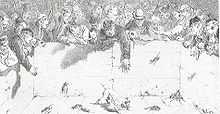
James Wentworth Day, a follower of the sport of rat baiting, described his experience and atmosphere at one of the last old rat pits in London during those times.
- "This was a rather dirty, small place, in the middle of the Cambridge Circus, London. You went down a rotten wooden stair and entered a large, underground cellar, which was created by combining the cellars of two houses. The cellar was full of smoke, stench of rats, dogs and dirty human beings as well. The stale smell of flat beer was almost overpowering. Gas lights illuminated the centre of the cellar, a ring enclosed by wood barriers, similar to a small Roman circus arena and wooden bleachers, arranged one over the other, rose stepwise above it nearly to the ceiling. This was the pit for dog fights, cockfights and rat killing. A hundred rats were put in it, large wagers went back and forth on whose dog could kill the most rats within a minute. The dogs worked in exemplary fashion, a grip, a toss and it was all over for the rat. With especially skilful dogs, two dead rats flew through the air at the same time..."
Rules
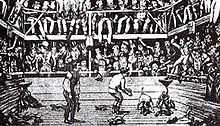
The officials included a referee and timekeeper. Pits were sometimes covered above with wire mesh or had additional security devices installed on the walls to prevent the rats from escaping. Rules varied from match to match.
In one variation there was a weight handicap for each dog. The competing dog had to kill as many rats as the number of pounds the dog weighed, within a specific preset time.[2] The prescribed number of rats was released and the dog was put in the ring. The clock started the moment the dog touched the ground. When the dog seized the last rat, his owner grabbed it and the clock stopped.

Rats that were thought still to be alive were laid out on the table in a circle before the referee. The referee then struck the animals three times on the tail with a stick. If a rat managed to crawl out of the circle, it was considered to be alive.[2] Depending on the particular rules for that match, the dog may be disqualified or have to go back in the ring with these rats and kill them. The new time was added to the original time.
A combination of the quickest time, the number of rats and the dog's weight decided the victory. A rate of five seconds per rat killed was considered quite satisfactory; fifteen rats in a minute was an excellent result.
Cornered rats will attack and can deliver a very painful bite. It was not uncommon to see a ratter left with only one eye in its retirement.
Rat-catcher
Before the contest could begin there was a requirement for the capture of potentially thousands of rats. The rat-catcher would be called upon to fulfill this requirement. Jack Black, a rat-catcher from Victorian England[3] supplied live rats for baiting.
Technique
Faster dogs were preferred. Rat killers bit but once. The process was described as "rather like a sheepdog keeping a flock bunched to be brought out singly for dipping," where the dog would herd the rats together, and kill any rats that left the pack with a quick bite.[2]
Breeds

The ratting dogs were typically working terrier breeds, which included, but were not limited to, the Bull and Terrier, Bull Terrier, Bedlington Terrier, Fox Terrier, Jack Russell Terrier, Rat Terrier, Black and Tan Terrier, Manchester Terrier, Yorkshire Terrier and Staffordshire Bull Terrier. The degree of care used in breeding these ratters is clear in their pedigree with good breeding leading to increased business opportunities. Successful breeders were highly regarded in those times.
Billy
A celebrated Bull and Terrier named "Billy" weighing approximately 12 kg (26 pounds), had a proud fighting history and the pedigree reflects the build-up over a period of years. The dog was owned by Charles Dew and was bred by the breeder James Yardington. On the paternal side is "Old Billy" from the kennel of John Tattersal from Wotton-under-Edge, Gloucestershire and was descended from the best line of all Old English Bulldogs. On the maternal side, is "Yardington's Sal" descended from the Curley line. The pedigree of all these dogs can be traced back more than forty years and there are numerous old accounts about them.
The October 1822, edition of The Sporting Magazine provided descriptions of two rat pit matches with Billy, quoted as follows:

- "Thursday night, Oct. 24, at a quarter before eight o'clock, the lovers of rat-killing enjoyed a feast of delight in a prodigious raticide at the Cockpit, Westminster. The place was crowded. The famous dog Billy, of rat-killing notoriety, 26 lb. weight, was wagered, for twenty sovereigns, to kill one hundred rats in twelve minutes. The rats were turned out loose at once in a 12-feet square, and the floor whitened, so that the rats might be visible to all. The set-to began, and Billy exerted himself to the utmost. At four minutes and three quarters, as the hero's head was covered with gore, he was removed from the pit, and his chaps being washed, he lapped some water to cool his throat. Again he entered the arena, and in vain did the unfortunate victims labour to obtain security by climbing against the sides of the pit, or by crouching beneath the hero. By twos and threes they were caught, and soon their mangled corpses proved the valour of the victor. Some of the flying enemy, more valiant than the rest, endeavoured by seizing this Quinhus Flestrum of heroic dogs by the ears, to procure a respite, or to sell their life as dearly as possible; but his grand paw soon swept off the buzzers, and consigned them to their fate. At seven minutes and a quarter, or according to another watch, for there were two umpires and two watches, at seven minutes and seventeen seconds, the victor relinquished the glorious pursuit, for all his foes lay slaughtered on the ensanguined plain. Billy was then caressed and fondled by many; the dog is estimated by amateurs as a most dextrous animal; he is, unfortunately, what the French Monsieurs call borg-ne, that is, blind of an eye.-This precious organ was lost to him some time since by the intrepidity of an inimical rat, which as he had not seized it in a proper place, turned round on its murderer, and reprived him by one bite of the privilege of seeing with two eyes in future. The dog BILLY, of rat-killing notoriety, on the evening of the 13th instant, again exhibited his surprising dexterity; he was wagered to kill one hundred rats within twelve minutes; but six minutes and twenty five seconds only elapsed, when every rat lay stretched on the gory plain, without the least symptom of life appearing.' Billy was decorated with a silver collar, and a number of ribband bows, and was led off amidst the applauses of the persons assembled."
Billy's best competition results are as follows:
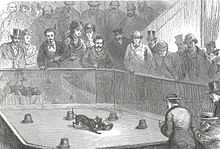
| Date | Rats Killed | Time | Time per Rat | |
|---|---|---|---|---|
| 1820-??-?? | 20 | 1 minute, 11 seconds | 3.6 seconds | |
| 1822-09-03 | 100 | 8 minutes, 45 seconds | 5.2 seconds | |
| 1822-10-24 | 100 | 7 minutes, 17 seconds | 4.4 seconds | |
| 1822-11-13 | 100 | 6 minutes, 25 seconds | 3.8 seconds | |
| 1823-04-22 | 100 | 5 minutes, 30 seconds | 3.3 seconds | * Record |
| 1823-08-05 | 120 | 8 minutes, 20 seconds | 4.1 seconds |
Billy's career was crowned on 22 April 1823, when a world record was set with a hundred rats killed in five-and-a-half minutes. This record stood until 1862 when it was claimed by another ratter named "Jacko". Billy continued in the rat pit until old age reportedly with only one eye and two teeth remaining.
Jacko
According to the Sporting Chronicle Annual, the world record in rat killing is held by a black and tan Bull Terrier named "Jacko" weighing about thirteen pounds and owned by Jemmy Shaw.[4] Jacko had the following contest results:
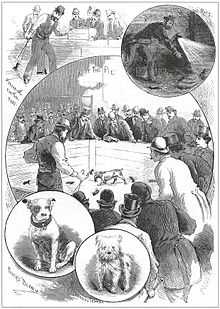
| Date | Rats Killed | Time | Time per Rat | |
|---|---|---|---|---|
| 1861-08-08 | 25 | 1 minute, 28 seconds | 3.5 seconds | |
| 1862-07-29 | 60 | 2 minutes, 42 seconds | 2.7 seconds | * Record |
| 1862-05-01 | 100 | 5 minutes, 28 seconds | 3.3 seconds | * Record |
| 1862-06-10 | 200 | 14 minutes, 37 seconds | 4.4 seconds | |
| 1862-05-01 | 1000 | in less than 100 minutes | 6.0 seconds |
Jacko set two world records, the first on 29 July 1862, with a killing time of 2.7 seconds per rat and the second on 1 May 1862, with his fight against one hundred rats, where Jacko worked two seconds faster than the previous world record holder "Billy". The feat of killing 1,000 rats took place over a ten-week period, with one hundred rats being killed each week ending on 1 May 1862.
Decline
The last public competition took place in Leicester in 1912. The owner was prosecuted, fined and had to give a promise to the court that he would never again promote such entertainment.[1] Toward the latter half of Queen Victoria's reign, a more humane attitude to the canine race gradually emerged, the queen's love of animals setting the example. Baiting sports diminished in popularity and the exhibition of dogs slowly replaced the attractions of the dog pit.
-

The Graham Arms -

Lancaster in 1912 -
_b_733.jpg)
See also
- Bait (dogs)
- Huddersfield Ben
- List of blood sports
References
- ↑ 1.0 1.1 C & G's Crazy Critters Rattery. "Ratting History: A Night at the Rat Pit". Archived from the original on 23 March 2006. Retrieved 14 July 2006.
- ↑ 2.0 2.1 2.2 Phil Drabble (1948). "Staffords and baiting sports". In Brian Vesey-Fitzgerald, ed. The book of the dog. Los Angeles: Borden Publishing.
- ↑ Henry Mayhew (1851). "Jack Black". London Labor and the London Poor 3. London: Griffen, Bohn and Company.
- ↑ Mayhew, H. (1851). London Labour and the London Poor, Volume 3, Pg. 9. London: Griffen, Bohn and Company, Stationer's Hall Court.
Further reading
- Fleig, D. (1996). History of Fighting Dogs. pg 105 - 112 T.F.H. Publications. ISBN 0-7938-0498-1
- Homan, M. (2000). A Complete History of Fighting Dogs. pg 121 - 131 Howell Book House Inc. ISBN 1-58245-128-1
- Mayhew, H. (1851). London Labour and the London Poor, Volume 3, Pg. 5. London: Griffen, Bohn and Company, Stationer's Hall Court.
- Sullivan, R. (2004). Rats : Observations on the History and Habitat of the City's Most Unwanted Inhabitants. Chapter 9 Bloomsbury USA. ISBN 1-58234-385-3
External links
| Wikimedia Commons has media related to Rat-baiting. |